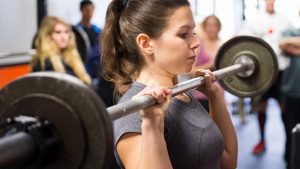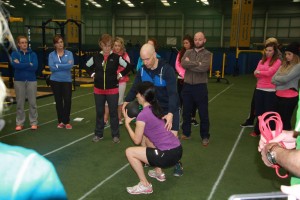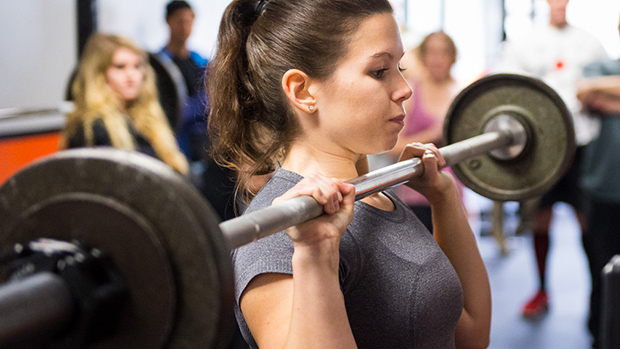
Irish boxer, Katie Taylor, has just launched her professional boxing career with a win. She trains as any athlete should – for strength, power, conditioning, etc… In my opinion, she epitomises what all sports should be about – and particularly, athleticism.
It seems to me that the biggest challenge with regard to women doing strength training is that there are too few doing it! There are many reasons for this. A US study1 illustrated a few reasons why women shy away from strength training:
- Both the female athletes and the coaches saw strength training as less vital for the female athletes than the male athletes.
- The females were not as confident with regard to weight training as the men.
- The females saw weight training as a masculine activity.
Other reasons may be:
- Women are self-conscious about entering the weight section of a gym.
- They associate weight training with becoming larger and heavier.
- They believe females should not lift heavy weights.
I will attempt to dispel these notions, and also address certain female-only factors in fitness such as menstruation, use of oral contraceptive pill (OCP), etc…
Few have done more to illustrate the benefits of strength and power training in women’s sport than the Williams sisters in Tennis. The sheer athleticism and power they display when playing is testimony to their scientific and balanced training regime. Some major benefits of strength training for women are:
- Increase bone mineral density (BMD): Women are prone to this disease as they age. In fact, research2 has shown that women are seven times more likely to suffer from low BMD if they haven’t partaken in sporting activities when younger.
- Reduced risk of injury: By doing rational strength training, females can strengthen connective tissue such as ligaments and tendons, thereby improving joint stability.
- Improved performance in sport: Once the key areas such as maximum strength and power are attended to, there is tremendous potential for increased physicality and performance in sport.
- Improved body composition: Body fat decreases as a result of increased muscle tissue development. Because muscle tissue is more compact, but also heavier than fat, it would not be unusual for a lady to fit better in her clothes yet her weight stay the same or even slightly increase, due to strength training.
Key Factors

- Women can match men proportionately in terms of lower body strength. However, there is a disparity between male and female upper body strength. This also means that women have the greater potential for improvement and can demonstrate this if they lift enough weight, the right way.
- Women have a smaller cross-section of muscle fibres resulting in less demonstrable strength. Because so many sports require powerful movements, females participating in these need to work extra hard at developing power in the weights room by stimulating the development of as many fast twitch, type II fibres as possible.
- Women need to abandon their fear of looking like men as a result of doing strength training; otherwise, the quality of their strength training may suffer. The major factor resulting in hypertrophy in men is the high levels of testosterone they produce since puberty. These levels may be as high as ten or twenty times women’s levels3. Therefore, women need not fear building huge muscles unless they are ingesting testosterone or anabolic steroids. It seems women have higher resting levels of Growth Hormone (GH), on average, than men which may compensate for the low levels of testosterone and allow women to undergo strength training adaptations.
- The use of OCP by women can provide certain advantages for female athletes. While there may be a small increased risk of breast cancer (if using OCP for 10+ years without having children) and reduced aerobic capacity, some training benefits of using OCP are4:
- Can reduce the natural fluctuations in strength throughout the menstrual cycle
- Seems to reduce carbohydrate usage in prolonged training
- Reduced menstrual blood loss
- May reduce premenstrual symptoms, so will have less effect on training and competitions
All women taking OCP should educate themselves fully on the pros and cons of usage.
- Observations indicate that the menstrual cycle need not have any major bearing on performance. It is not unusual for highly trained females to experience secondary amenorrhea (cessation of periods). Careful attention to nutrition and healthy lifestyle are all key factors in minimising menstrual disruption. In any case, menstrual symptoms can be highly individual to the particular athlete. (Zatisiorsky and W. Kraemer, 2006)
- Women need not stop strength training when they become pregnant, but adjustments in the program may need to be made, specifically:
- Avoid introducing any new exercises to a programme.
- Eliminate sit-ups from the program.
- Due to hormonal changes which soften connective tissue and increase risk of injury, pregnant women should reduce intensity of strength exercises.
It is strongly advisable for a female athlete to communicate with her doctor regarding her training programme.
Training Tips for Female Athletes
- Learn the correct technique of the strength exercises before loading up.
- Women undergo the same type of adaptations as men, so should use similar programmes, exercises and relative resistance as men.
- To increase bone mineral density, and reduce risk of osteoporosis, use multi-joint exercises that stress the skeleton, e.g squats, deadlifts, standing barbell press, etc…
- To compensate for less relative upper body strength, women need to do extra work for development of these muscles.
References
- Peak Performance Resistance Special report, Chapter “Women and Young Athletes,”, by Paul Gamble, page 58
- Peak Performance Resistance Special report, Chapter “Women and Young Athletes,”, by Paul Gamble, page 61
- Science and Practice of Strength Training. 2nd Edition, (Human Kinetics 2006), by V. Zatisiorsky and W. Kraemer, page 183
- Peak Performance, Female Athletes (Training for Success), Chapter – Performance and the Pill, pages 26-27, by Andrew Harrison.


